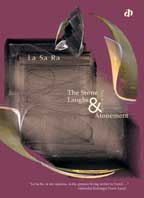
The Hindu
(Literary Review, August 6, 2006)
"A touch of the mystical ..."
Life as an orphan
Dharmarajan was orphaned when very young and his uncle, a temple priest, brings him up. The story begins with him meeting his cousin Mani, who has taken up the job of the priest after his father. Dharmu strikes a deal with Mani to take his place in the temple one day in the week and perform the rituals for the goddess. Dharmu had started out as a travelling salesman and eventually works in a bank where he helps Gomathi get a job there as well. After a gap of 12 years he runs into her and the two catch up on the major events of their lives in the intervening period.
Gomathi is tied down by her gambler husband and finds her joy in her son Prashanth. She's had to pawn her jewels with Manekchand. She worships the ground Dharmu walks on though the latter has a daughter as old as her. Gushes to his face about his fair appearance, good looks, culinary skills, perfectionism, "you seem an illusion, not even a poem, but only the memory of poetry". He is tall, his hair shines like pure white silk, impressive in his flowing white muslin garments, he stands clear as a waterfall.
His landlord, a Nadaar, venerates him and the exaggerated hospitality and adoration are fulsome. All this because of his arresting appearance and Dharmu at one point laments, "my looks are my misfortune". He goes to Manekchand to work as his cook and the seth mistakes him for a European! The sowcar treats him as his brother, but our man steals the bundle containing Gomathi's jewels. The same morning his employer dies and the needle of suspicion points to Dharmu. The first novella ends here and the next picks up the thread from there.
Broad strokes
The protagonist is awarded a prison term of five years but because of his good conduct he is out after three and a half years. But the further he runs from relationships the harder they chase him. His first meeting with Maragatham is explosive: as a salesman once he has to make do with an overnight stay in a village priest's house. In the night's darkness near the well in the backyard when he slips and falls she pleads with him, a total stranger, to take her away from there. The marriage is soon on the rocks and the mother and dancer-daughter leave him.
A very striking feature of La.Sa.Ra.'s writing is his characterisation. At the outset he paints his protagonist with broad strokes — a handsome rascal as it were — but gradually the character evolves and it becomes clear he is not a smooth operator but is a gentleman after all. In contrast, Gomathi comes off as a tepid character, cloying and weak. The other two women in the story, Maragatham and Madhu, are tarred and damned from the word go. Nadaar fears Dharmu might melt into thin air and Gomathi too echoes the sentiment. Aachchi believes that after Dharmu leaves, misfortunes pile up on her. The mysterious element about the lead character is thus accentuated. His one-sided dialogue with his beloved flute touches on the mystical.
Pithy sayings and rhetorical queries abound: "We have an infinite capacity to deceive ourselves". "What we generally see around us is the jackal groaning while the elephant carries the burden".
Central motif
The motif of the stone in both the novellas and the title is central to the theme and symbolic. The hero first interprets the smile of the deity as giving him the go-ahead for the questionable action planned. But as punishment to the crime committed overtakes him in no time, he begins to believe that the stone goddess is laughing at him and his folly. The devotee's adoration and indulgence are complete and life with its many unexpected twists and turns is no longer a puzzle or sheer misery.
The author takes the easy way out to tie up the loose ends. In the last seven pages of the book he assembles all the salient characters together and gets the protagonist to explain threadbare all his actions.
- Seline Augustine
The New Indian Express
(Sunday Express, August 27, 2006)
The Stone Laughs and Atonement by La Sa Ra (two novellas) are about Gomathi and Dharmarajan who are stuck in their everyday routine lives. United by an uncommon bond that defies definition, their paths cross again and again till they realise the absolute they seek lie within. As Gabriella Eichinger Ferro-Luzzi, the famous dravidiologist, puts it, “Dharmarajan’s spiritual experiences and his relationship with the goddess Kamalambikai in the two novellas are infused with a passion both subtle and assertive. La Sa Ramamirtham was a banker and writer who was part of the avant garde “Manikodi” movement of the 1930s and 40s. Though his style is difficult, and full of his philosophical preoccupations, he has a major fan following. And a new book by him was a much looked forward to event.
This translation will open doors to a generation grown up without having been exposed to the world of La Sa Ra.
The author
The translator
Publishers: Katha
Language: English
Cover Design: Netra Shyam
Cover Photograph Courtesy: Ebe Chaney
ISBN 81-87649-72-0
Price: Rs 200


0 Comments:
Post a Comment
<< Home